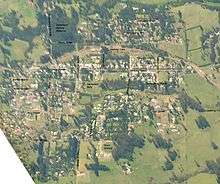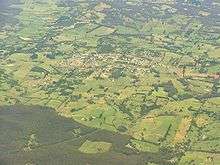Robertson, New South Wales
| Robertson New South Wales | |||||||||||||
|---|---|---|---|---|---|---|---|---|---|---|---|---|---|
|
Memorial to Railway Workers. | |||||||||||||
 Robertson | |||||||||||||
| Coordinates | 34°35′S 150°35′E / 34.583°S 150.583°ECoordinates: 34°35′S 150°35′E / 34.583°S 150.583°E | ||||||||||||
| Population | 1,849 (2011 census)[1] | ||||||||||||
| Postcode(s) | 2577 | ||||||||||||
| Elevation | 731 m (2,398 ft) | ||||||||||||
| Location |
| ||||||||||||
| LGA(s) | Wingecarribee Shire | ||||||||||||
| Region | Southern Highlands | ||||||||||||
| State electorate(s) | Goulburn | ||||||||||||
| Federal Division(s) | Whitlam | ||||||||||||
| |||||||||||||
Robertson is a large village in the Southern Highlands of New South Wales, Australia, in Wingecarribee Shire. The town is located on the edge of an elevated plateau (the Illawarra escarpment) about 35 km from the coast. At the 2011 census, Robertson and its surrounding area had a population of 1,849 people.[1]
Robertson is known for its high annual rainfall and fertile soil. It was previously covered by an extensive temperate rainforest, most of which has been cleared for farming though remnants such as Robertson Nature Reserve still exist today. The town is colloquially known as "Robbo" by the locals.
The town was once famous for cheese production. Today, the remnants of the industry are seen with one of the old cheese factories remaining in the town; it has been converted into a commercial row of shops.
Robertson is now more widely known for potato growing and is the home of the "Big Potato". The Big Potato was built in the 1970s by a local potato grower.
Robertson is also where the 1995 movie Babe was filmed.
Robertson is named after former Premier of New South Wales Sir John Robertson, whose 1861 Land Act cleared the way for the establishment of the town.[2] Before then it was called Yarrawa Bush.
Events


In February or March of each year the Robertson Show is held, featuring "The Great Australian Potato Race".
In Spring Robertson holds a spring festival, with local gardens open to the public.
Attractions
Robertson Hotel
Robertson is home to the famous hotel "Robertson Hotel" a popular hotel, wedding Robertson Hotel was originally built in 1924 and opened as Hotel Robertson, has had an interesting history. The Hotel boasted a nine-hole golf course, two tennis courts, croquet, lawn bowls, billiards, fishing, hunting, horseback riding, and an onsite mechanic who looked after guest’s cars during their stay. The hotel won the "Most luxurious hotel in the Commonwealth" award in 1925, and was the first hotel in Australia to have phone lines to every room.
The Hotel was built to draw some of the Sydneysiders, who in the past retreated to the cool climate of the Southern Highlands to escape the heat of a Sydney summer and enjoy the beauty of the countryside. The Hotel was a success and the developer went on to subdivide and develop the local area. This unfortunately was not a success.
In 1930 the hotel was sold and marketed as an exclusive country club and renamed Ranelagh Country Club after Ranelagh Gardens in London. However, the Great Depression made those plans short lived.
In the buildup to World War II the hotel became a WRAAF base, serving as a signals base and a training area for budding pilots. After World War II, the hotel was used as a hospice for returned pilots.
The building sold again in 1947 and became, St Anthony's College, a Franciscan friary and seminary, during this period the hotel was also used as a school and accommodation house run by the monks. It was during this period that the beautiful stained glass windows, rock walls and fountains were built. These are still in the building and around the gardens and grounds.
The Hotel has its own railway platform on the Moss Vale – Unanderra line, which is still used today.
In 1972 the Monks moved to smaller premises in Campbelltown and the building returned to its intended use as a hotel, named Ranelagh House.
The Hotel was sold again in late 2007, and was renamed Fountaindale Grand Manor and Ranelagh Gardens, the hotels is undergoing major renovations and refurbishments. Recently it was renamed to Robertson Hotel.[3]
Illawarra Fly
On 15 March 2008, the Illawarra Fly Tree Top Walk opened to the public. It is similar to the Otway Fly,[4] in Victoria. It is perched on the Illawarra escarpment at Knights Hill, located east of Robertson. The tree top walk is joined up with an observation outdoor tower that will allow visitors to see spectacular views of Wollongong. It is expected approximately 200,000 visitors every year.[5]
The Big Potato
Built in 1977 by local potato grower Jim Mauger, the Big Potato adorns the main street at the eastern end of town. It was modelled on the Sebago potato and is approx ten metres long and four metres wide. The original idea was for this structure to contain a Potato Information Centre but rising costs chipped away at this dream and in the end it boiled down to nothing. Recently the locals of Robertson have worked together to turn the surrounding land into a park to be enjoyed by locals and tourists alike.
On 6 March 2010 a group of young people adorned the potato with a very large face, to help brighten up the tourist attraction for the local agricultural show. It was built in secret during the weeks leading up to the show and even the owners of the potato and the surrounding land had no idea that it was going to happen. Sadly this work of guerilla art was torn down and damaged on its first night, but it generated enough buzz to appear in a few newspapers, several news websites, blogs, national radio and two members of the group were asked to appear on the national TV show The 7pm Project. Despite requests to rehang the face the artists considered the damage to be too significant to rehang it, but had not ruled out repairing it and putting it back up for a future special occasions. In 2011 on same weekend in March the artists sneaked back into the village in the early morning and rehung the repaired face on the big potato. It has since been donated to the local chamber of commerce to be used for promotional/tourist purposes and has been hung to promote the Robertson Christmas in July festivities in 2012 and, with the addition of a santa hat, in 2013.
Transport

Robertson was served by a railway station on the Unanderra Moss Vale railway line. The railway line is mainly used for freight. Occasionally, a tourist train travels from Sydney to Moss Vale and return (via Wollongong), but is not used by passenger services.
CountryLink buses travel along the Illawarra Highway, three times a day that have replaced passenger trains, linking the Southern Highlands to Wollongong. The Illawarra Highway winds down the escarpment via the notorious Macquarie Pass. Robertson would be a major beneficiary of a major upgrade or replacement to Macquarie Pass. Despite most Illawarra and Highland residents strongly supporting a major improvement to the link between Robertson and Albion Park, no government has shown any interest in such a project.
Notable residents
- Nathan Hindmarsh: Parramatta Eels NRL player who grew up in the town. Born in Bowral.
- Ian Hindmarsh: brother of Nathan and retired NRL player. Born in Bowral.
- Noeline Brown: Australian entertainer.
- Bob Dwyer: former Australian Wallabies rugby union coach
- Brett Lee: Australian cricketer, owns property near town
- Miriam Margoyles: British-born actress
- Ben Quilty: award-winning artist
- Carlos Barrios: Australian El Salvadoran artist
- John Waters (actor): English-born actor.
References
- 1 2 Australian Bureau of Statistics (31 October 2012). "Robertson (State Suburb)". 2011 Census QuickStats. Retrieved 7 April 2015.
- ↑ Cite: http://nla.gov.au/nla.news-article13117116
- ↑ http://www.fountaindale.com.au/ Fountaindale Grand Manor
- ↑ http://www.otwayfly.com/
- ↑ http://www.illawarrafly.com/ Illawarra Fly Tree Top Walk web